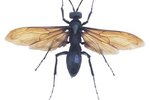
The rufous hummingbird (Selasphorus rufus) is a diminutive North American fixture, with a broad scope that encompasses the United States, Canada, Mexico and the Lesser Antilles. Rufous hummingbirds are prevalent throughout a vast array of habitats, including parks, coniferous forests, outskirts of forests, gardens and shrublands. It also isn't at all rare to spot a rufous hummingbird in a neighborhood environment. The word "rufous" in their name means "reddish-brown," which describes these wee hummingbirds quite well. Since rufous hummingbirds are highly solitary by nature, you're unlikely to see more than one at a time.
Rufous Hummingbird Size
These dainty, bug-eating hummingbirds are usually between 3 and 4 inches long, according to Wildlife Journal Junior. Their wingspans are usually around 4 inches. And rufous hummingbirds are serious lightweights—literally. They usually tip the scales at somewhere between 0.10 and 0.14 ounces, indicates Animal Diversity Web for the University of Michigan. The rufous hummingbird physique is on the squat and stumpy side.
Rufous Hummingbird Body Coloration
Male rufous hummingbirds are light reddish-brown in color, with bright crimson throats, green wings, reddish-orange tails and pale chests. Female rufous hummingbirds, on the other hand, have green backs, white undersides, orange markings on their throats and reddish-brown flanks. Not all females have the throat markings, however. In the fairer sex, the tails are green, black and orange, with rufous coloring at the base. The female's tail feathers have white tips, while the male's have black ones instead. As youngsters, rufous hummingbirds are visually similar to female adults. However, their beaks are markedly more crinkled in appearance. The rufous hummingbird is similar in appearance to Allen's hummingbird (Selasphorus sasin), a fellow tiny avian. One key difference between the species, however, is that male Allen's hummingbirds have green backs, rather than reddish-brown backs.
Rufous Hummingbird Bills
Rufous hummingbirds have lengthy, narrow and almost perfectly straight bills that are deep brown or black.
Rufous Hummingbird Feet
Rufous hummingbirds have dainty, small feet. These inconspicuous feet are usually a murky dark brown or black.
References
- National Geographic: Rufous Hummingbird
- IUCN Red List of Threatened Species: Selasphorus rufus
- University of Michigan Animal Diversity Web: Selasphorus rufus
- BirdWeb: Rufous Hummingbird
- Audubon Watchlist: Rufous Hummingbird
- U.S. Fish & Wildlife Service: Rufous Hummingbirds
- Wildlife Journal Junior: Rufous Hummingbird
- Montana Field Guide: Rufous Hummingbird
Photo Credits
-
Photos.com/AbleStock.com/Getty Images


